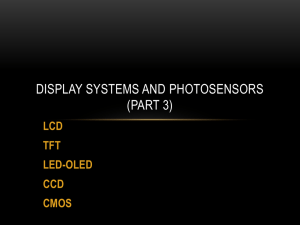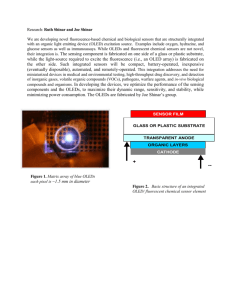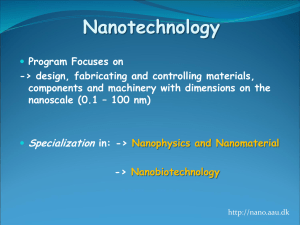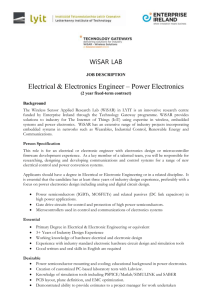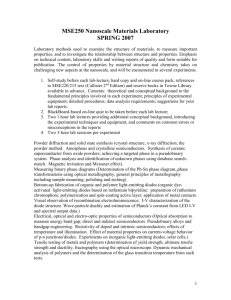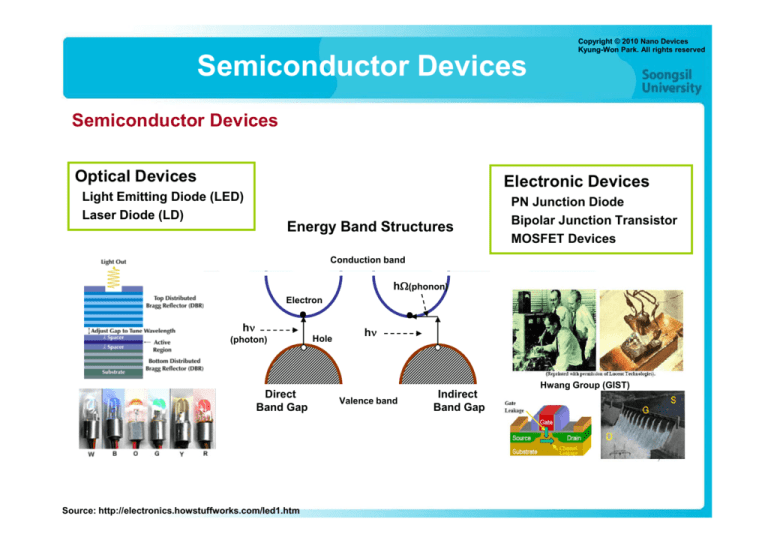
Semiconductor Devices
Copyright © 2010 Nano Devices
Kyung-Won Park. All rights reserved
Semiconductor Devices
Optical Devices
Electronic Devices
Light Emitting Diode (LED)
Laser Diode (LD)
Energy Band Structures
PN Junction Diode
Bipolar Junction Transistor
MOSFET Devices
Conduction band
hΩ(phonon)
Electron
hν
(photon)
Direct
Band Gap
Source: http://electronics.howstuffworks.com/led1.htm
Hole
hν
Valence band
Indirect
Band Gap
Hwang Group (GIST)
Copyright © 2010 Nano Devices
Kyung-Won Park. All rights reserved
Extrinsic, Elemental Semiconductors
Intrinsic Semiconductor
: Pure material (4 valence electrons)
ex) Si, Ge
Extrinsic Semiconductor
: Impurity additions (Dopants)
Extrinsic Semiconduction
: Resulting from dopants
(1) n-type : negative charge carriers dominates
Intrinsic Semiconductors (4 valence electrons)
+ V A elements
l
t (5 valence
l
electrons)
l t
)
= One extra electron = A conduction electron
(2) p-type : positive charge carriers dominates
Intrinsic Semiconductors (4 valence electrons)
+ III A elements (3 valence electrons)
= Deficiency of one electron = An electron hole
Source: http://electronics.howstuffworks.com/led1.htm
Copyright © 2010 Nano Devices
Kyung-Won Park. All rights reserved
Extrinsic, Elemental Semiconductors
n-type Semiconductors
(1) Intrinsic Semiconductors + V A elements
= Extra electrons = Conduction electrons
(2) The addition of a group V A atom into solid
solution in a crystal of group IV A
→ Modified energy band structure
n-type Semiconductor
II II
II
= Si = Si = Si =
•
II II
II e= Si = As = Si =
II II
II
= Si = Si = Si =
II II
II
“N-type”
Source: http://electronics.howstuffworks.com/led1.htm
Diamond
a o d cubic
cub c
structure
Copyright © 2010 Nano Devices
Kyung-Won Park. All rights reserved
Extrinsic, Elemental Semiconductors
p-type Semiconductors
(1) Intrinsic Semiconductors + III A elements
= Deficiency of electrons = Electron holes
(2) The addition of a group III A atom into solid
solution in a crystal of group IV A
→ Modified energy band structure
p-type Semiconductor
II II
II
= Si = Si = Si =
II II
II
= Si = B = Si =
I ◦h+ II
II
= Si = Si = Si =
II II
II
Source: http://electronics.howstuffworks.com/led1.htm
“P-type”
P type
Light Emitting Diodes (LEDs)
Copyright © 2010 Nano Devices
Kyung-Won Park. All rights reserved
1. What is a Diode?
• At the junction, free electrons from the N-type material
fill holes from the P-type material.
• This creates an insulating layer in the middle of the
diode called the depletion zone.
Source: http://electronics.howstuffworks.com/led1.htm
Light Emitting Diodes (LEDs)
Copyright © 2010 Nano Devices
Kyung-Won Park. All rights reserved
1. What is a Diode?
• A diode is the simplest sort of semiconductor device.
• Broadly speaking, a semiconductor is a material with a varying
ability to conduct electrical current.
• Most semiconductors are made of a poor conductor that has had
impurities (atoms of another material) added to it. The process of
adding
add
g impurities
pu t es is
s called
ca ed dop
doping.
g
Source: http://electronics.howstuffworks.com/led1.htm
Light Emitting Diodes (LEDs)
Copyright © 2010 Nano Devices
Kyung-Won Park. All rights reserved
1. What is a Diode?
When the negative end of the circuit is
hooked up to the N-type layer and the
positive end is hooked up to P-type layer,
electrons and holes start moving and the
depletion zone disappears.
Source: http://electronics.howstuffworks.com/led1.htm
When the positive end of the circuit is
hooked up to the N-type layer and the
negative end is hooked up to the P-type
layer, free electrons collect on one end of
the diode and holes collect on the other
other.
The depletion zone gets bigger.
Light Emitting Diodes (LEDs)
2. How Can a Diode Produce Light?
Source: http://electronics.howstuffworks.com/led1.htm
Copyright © 2010 Nano Devices
Kyung-Won Park. All rights reserved
Light Emitting Diodes (LEDs)
Copyright © 2010 Nano Devices
Kyung-Won Park. All rights reserved
3. Advantages
• LEDs have several advantages
over conventional lamps.
• For one thing, they don't have a
filament that will burn out, so they
last much longer.
• Additionally, their small plastic
bulb makes them a lot more durable.
durable
• They also fit more easily into
modern electronic circuits.
Source: http://electronics.howstuffworks.com/led1.htm
Copyright © 2010 Nano Devices
Kyung-Won Park. All rights reserved
Organic Light Emitting Diodes (OLEDs)
1. OLED Structure
• Substrate (clear plastic, glass, foil) Th substrate
The
b t t supports
t the
th OLED.
OLED
• Anode (transparent) - The anode
removes electrons (adds electron
"holes") when a current flows through
the device.
• Organic layers - These layers are
made of organic molecules or
polymers.
Source: http://electronics.howstuffworks.com/led1.htm
Copyright © 2010 Nano Devices
Kyung-Won Park. All rights reserved
Organic Light Emitting Diodes (OLEDs)
1. OLED Structure
• Conducting layer - This layer is made
of organic plastic molecules that
transport "holes" from the anode.
(Polyaniline)
• Emissive layer - This layer is made of
organic plastic molecules (different ones
from the conducting layer) that transport
electrons from the cathode; this is where
light is made. (Polyfluorene)
j
• Cathode - The cathode injects
electrons when a current flows through
the device.
Source: http://electronics.howstuffworks.com/led1.htm
Copyright © 2010 Nano Devices
Kyung-Won Park. All rights reserved
Organic Light Emitting Diodes (OLEDs)
2. Fabrication of OLED
• Vacuum deposition or vacuum thermal
evaporation (VTE) - In a vacuum chamber, the
organic molecules are gently heated (evaporated)
and
d allowed
ll
d to condense
d
as thin
hi films
fil
onto cooled
l d
substrates.
• Organic
g
vapor
p phase
p
deposition
p
(OVPD)
(
) - In a
low-pressure, hot-walled reactor chamber, a
carrier gas transports evaporated organic
molecules onto cooled substrates, where they
condense into thin films.
• Inkjet printing - OLEDs are sprayed onto
substrates just like inks are sprayed onto paper
during printing. Inkjet technology greatly reduces
the cost of OLED manufacturing and allows
printed onto very
y large
g films for large
g
OLEDs to be p
displays like 80-inch TV screens or electronic
billboards.
Source: http://electronics.howstuffworks.com/led1.htm
Copyright © 2010 Nano Devices
Kyung-Won Park. All rights reserved
Organic Light Emitting Diodes (OLEDs)
3. How Can OLEDs Produce Light?
OLEDs emit light in a similar manner
to LEDs, through
g a process
p
called
“Electrophosphorescence”.
Source: http://electronics.howstuffworks.com/led1.htm
Copyright © 2010 Nano Devices
Kyung-Won Park. All rights reserved
Organic Light Emitting Diodes (OLEDs)
4. Type of OLEDs
Passive-matrix OLED (PMOLED)
• PMOLEDs have strips of cathode,
organic layers and strips of anode.
• The anode strips are arranged
perpendicular
p
p
to the cathode strips.
p
• The intersections of the cathode and
anode make up the pixels where light is
emitted.
emitted
• External circuitry applies current to
selected strips of anode and cathode,
determining which pixels get turned on
and which pixels remain off.
• Again,
g , the brightness
g
of each pixel
p
is
proportional to the amount of applied
current
Source: http://electronics.howstuffworks.com/led1.htm
Copyright © 2010 Nano Devices
Kyung-Won Park. All rights reserved
Organic Light Emitting Diodes (OLEDs)
Active-matrix OLED (AMOLED)
• AMOLEDs
AMOLED h
have ffull
ll layers
l
off cathode,
th d
organic molecules and anode, but the
anode layer overlays a thin film transistor
(TFT) array that forms a matrix
matrix.
• The TFT array itself is the circuitry that
determines which pixels get turned on to
form an image.
• AMOLEDs consume less power than
PMOLEDs because the TFT array requires
less power than external circuitry, so they
are efficient for large displays.
• AMOLEDs also have faster refresh rates
suitable for video.
• The best uses for AMOLEDs are
computer monitors, large-screen TVs and
electronic signs or billboards.
Source: http://electronics.howstuffworks.com/led1.htm
Copyright © 2010 Nano Devices
Kyung-Won Park. All rights reserved
Organic Light Emitting Diodes (OLEDs)
5. Structure of OLED
Source: http://electronics.howstuffworks.com/led1.htm

